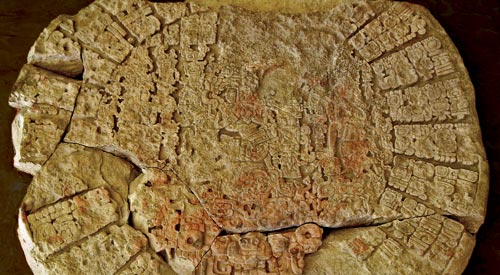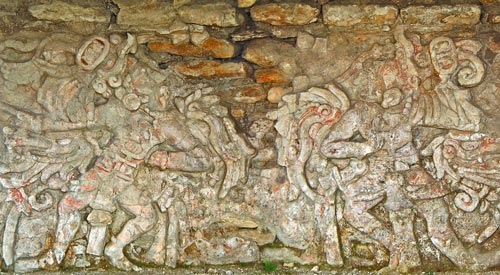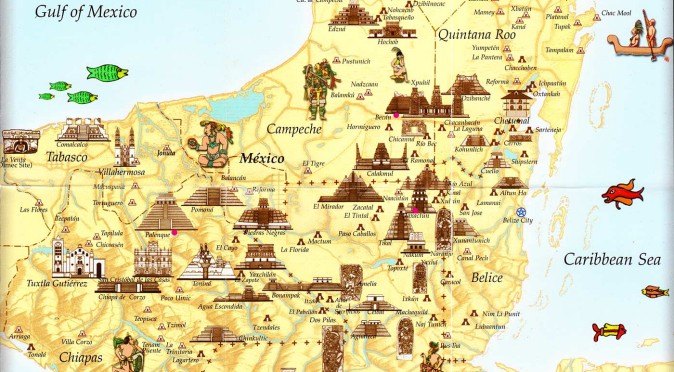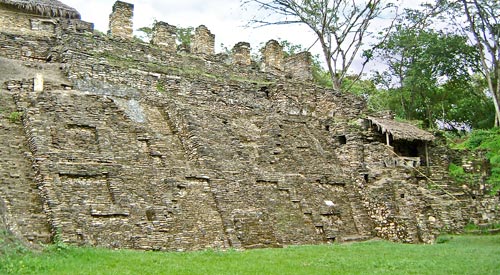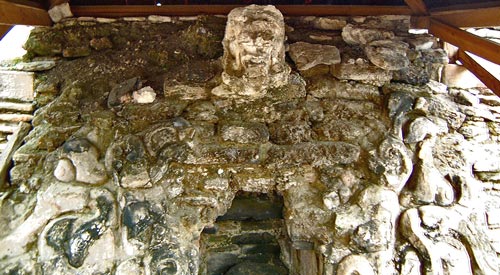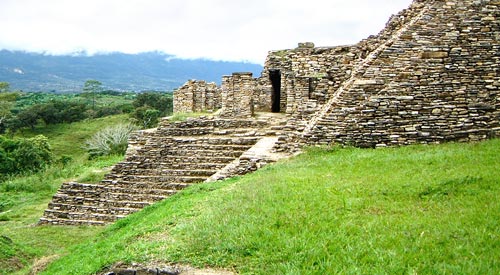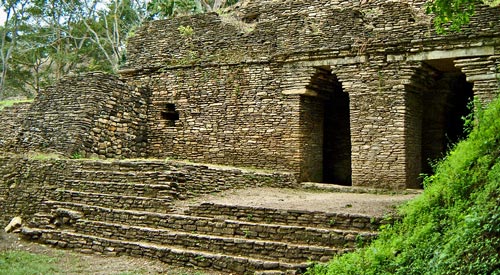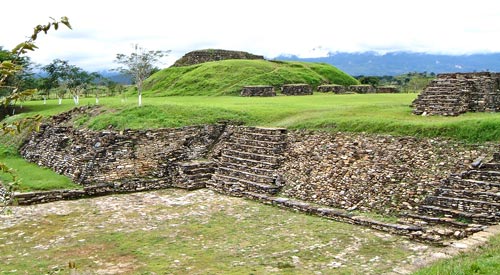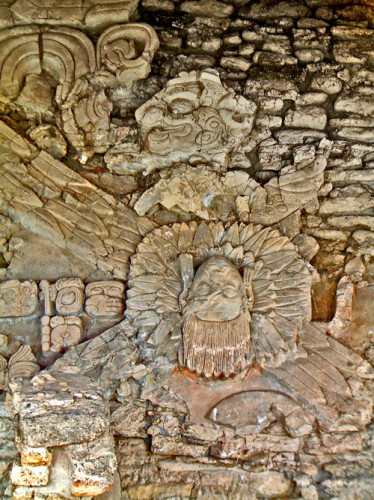 W0454: Mural De Las Cuarto ErasOn the fifth tier of Tonina’s acropolis is the Frieze of the Dream Lords, which is also known as the Frieze of the Four Suns and the Frieze of the Four Eras. Each name represents a difference in opinion in what the scenes represent – for which there is no definitive answer. The frieze measures 4 metres high by 16 metres long and was discovered during the 1990 season. Unfortunately, large sections of the frieze are missing, including the entire fourth panel, on which only an upside down head remains. This means that deciphering the massive stucco mural is almost impossible. What can be ascertained is that the original frieze comprised of four scenes, each boxed and divided into four triangular segments by lines of feathers, with an upside-down head at the centre. The head is ringed by feathers, which may represent regal status, but the feathers may be petals designed to represent the flowering of crops, or the rays of the sun, or blood pouring forth from the decapitated head – it is also possible that the feathers are intended to represent all of these symbolic references. It is these upside down heads that are thought to hold the key to deciphering the frieze, for a compendium of Mayan texts, called the Popol Vuh, records that the Mayan’s believed there had been four ages, with each age beginning with a God sacrificing themselves to become the Sun. It seems likely that the four upside down heads are representative of these four suns and the gods who gave their lives to create them, hence they are upside down, representing death, with rays emanating from them, representing the sun, and look like flowering crops, which represents the giving of life and sustenance. It is also thought that the heads represent ruling lineage of Tonina, hence the feathered collar, and that the frieze was designed to associate them with the creation myths. The quadrangles may represent the four seasons or the four directions, and therefore symbolise the recurring cycles of the sun’s transit and the scenes within them describe sacred rituals surrounding the calendar. Other sections appear to be associated with the stories of the Popol Vuh, with the dart blowing Hunahpu found in a lower quadrant of the first scene arched in the ball-playing position.
W0454: Mural De Las Cuarto ErasOn the fifth tier of Tonina’s acropolis is the Frieze of the Dream Lords, which is also known as the Frieze of the Four Suns and the Frieze of the Four Eras. Each name represents a difference in opinion in what the scenes represent – for which there is no definitive answer. The frieze measures 4 metres high by 16 metres long and was discovered during the 1990 season. Unfortunately, large sections of the frieze are missing, including the entire fourth panel, on which only an upside down head remains. This means that deciphering the massive stucco mural is almost impossible. What can be ascertained is that the original frieze comprised of four scenes, each boxed and divided into four triangular segments by lines of feathers, with an upside-down head at the centre. The head is ringed by feathers, which may represent regal status, but the feathers may be petals designed to represent the flowering of crops, or the rays of the sun, or blood pouring forth from the decapitated head – it is also possible that the feathers are intended to represent all of these symbolic references. It is these upside down heads that are thought to hold the key to deciphering the frieze, for a compendium of Mayan texts, called the Popol Vuh, records that the Mayan’s believed there had been four ages, with each age beginning with a God sacrificing themselves to become the Sun. It seems likely that the four upside down heads are representative of these four suns and the gods who gave their lives to create them, hence they are upside down, representing death, with rays emanating from them, representing the sun, and look like flowering crops, which represents the giving of life and sustenance. It is also thought that the heads represent ruling lineage of Tonina, hence the feathered collar, and that the frieze was designed to associate them with the creation myths. The quadrangles may represent the four seasons or the four directions, and therefore symbolise the recurring cycles of the sun’s transit and the scenes within them describe sacred rituals surrounding the calendar. Other sections appear to be associated with the stories of the Popol Vuh, with the dart blowing Hunahpu found in a lower quadrant of the first scene arched in the ball-playing position.
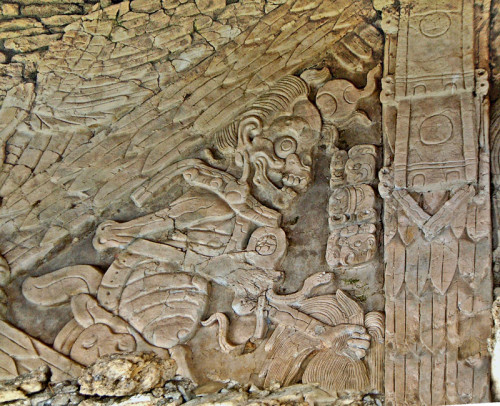 W0453: Frieze of the Dream LordsThe frieze is thought to have been constructed between 790AD and 840AD as Tonina’s religious emphasis shifted towards the celebration of the underworld. In fact, it is thought that Tonina’s seven levels represent a the transit through the underworld, and the ballcourts, buildings, monuments and friezes all relate to the journey that the Hero Twins undertook in their battle against the Lords of Xibalba. There are certainly scenes in the Frieze of the Four Eras that focus on the underworld, and in particular the skeletal god God A who looms large in the right quadrant of the third panel (see fig. W0453) is a clear symbol of otherworldly or paranormal activity. This Lord of Death holds a severed head in his left hand and a serpent in his right hand. He is identified by his turtle shoes – lending to the name Ak Ok Kimi, meaning Turtle Foot Death. This deathly character may be one of the lords of the underworld, who feature heavily in the myths of the Popol Vuh and are eventually defeated by the ball-playing Hero Twins, Hunaphu and Xbalanque. However, this character has also brought about theories that the scenes represent the “wayob” of the Maya elite. Wayob is the act of transfiguration into an animal or supernatural form through a deep meditation and was undertaken to perform an act requiring supernatural power. The scenes of Panel 3 and Panel 2, which between them picture strange deathly forms, men in slumber, surreal animals, and the recurring themes of feathers and flight, can certainly be construed as symbolising this supernatural act. This alternative theory has led to the piece being named the Frieze of the Dream Lords.
W0453: Frieze of the Dream LordsThe frieze is thought to have been constructed between 790AD and 840AD as Tonina’s religious emphasis shifted towards the celebration of the underworld. In fact, it is thought that Tonina’s seven levels represent a the transit through the underworld, and the ballcourts, buildings, monuments and friezes all relate to the journey that the Hero Twins undertook in their battle against the Lords of Xibalba. There are certainly scenes in the Frieze of the Four Eras that focus on the underworld, and in particular the skeletal god God A who looms large in the right quadrant of the third panel (see fig. W0453) is a clear symbol of otherworldly or paranormal activity. This Lord of Death holds a severed head in his left hand and a serpent in his right hand. He is identified by his turtle shoes – lending to the name Ak Ok Kimi, meaning Turtle Foot Death. This deathly character may be one of the lords of the underworld, who feature heavily in the myths of the Popol Vuh and are eventually defeated by the ball-playing Hero Twins, Hunaphu and Xbalanque. However, this character has also brought about theories that the scenes represent the “wayob” of the Maya elite. Wayob is the act of transfiguration into an animal or supernatural form through a deep meditation and was undertaken to perform an act requiring supernatural power. The scenes of Panel 3 and Panel 2, which between them picture strange deathly forms, men in slumber, surreal animals, and the recurring themes of feathers and flight, can certainly be construed as symbolising this supernatural act. This alternative theory has led to the piece being named the Frieze of the Dream Lords.

